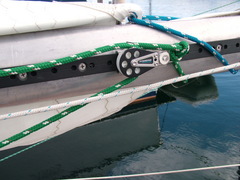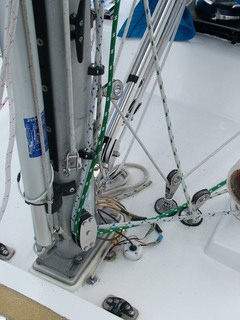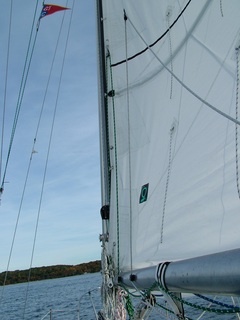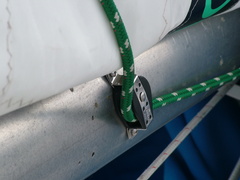
 The route my single line reefing system takes is as follows: After an initial figure eight knot the line goes through bail (or a eye strap) and under the boom and up to a cringle on the clew of the sail. From there the line goes down the side it started on to a cheek block and heads forward guided by a several eye straps.
The route my single line reefing system takes is as follows: After an initial figure eight knot the line goes through bail (or a eye strap) and under the boom and up to a cringle on the clew of the sail. From there the line goes down the side it started on to a cheek block and heads forward guided by a several eye straps.

 About a foot and a half or two feet from the goose neck it passes through a cheek block mounted on the boom at an angle and then goes up to a block mounted on a dog bone embedded in the luff clew. From there the line goes down and forward to a foot block mounted at the forward end of the mast.
About a foot and a half or two feet from the goose neck it passes through a cheek block mounted on the boom at an angle and then goes up to a block mounted on a dog bone embedded in the luff clew. From there the line goes down and forward to a foot block mounted at the forward end of the mast.

 Passing through the foot block ( a standup block would work as well) the line goes through a deck organizer and back to a rope clutch and winch.
Passing through the foot block ( a standup block would work as well) the line goes through a deck organizer and back to a rope clutch and winch.

 Two important things about this system need to be noted.
Two important things about this system need to be noted.
- Except for passing under the boom prior to passing through the clew cringle, the line remains on the same side of the boom at all times. This is very different from the Harken system which requires the reefing line to change from one side of the boom to another before it goes back to the cockpit.
- After the line passes through the block in the luff cringle, to work properly, the line must pull down and forward before it reaches the foot block or stand up block on the deck.

 The only modification I will make yet this fall or before sailing starts next spring is to add a fairlead close to the foot block at the base of the mast. I will do this because I have found that sometimes when the reefing lines are slack, the reefing line may come forward and wrap itself around the foot block. I do not think this problem would occur if I were using a standup block instead of a foot block.
The only modification I will make yet this fall or before sailing starts next spring is to add a fairlead close to the foot block at the base of the mast. I will do this because I have found that sometimes when the reefing lines are slack, the reefing line may come forward and wrap itself around the foot block. I do not think this problem would occur if I were using a standup block instead of a foot block.
I have provided two set of pictures: one set of pictures was taken with the sails furled. I thought it would be easier to show the path the line follows in this configuration. The green line is the second reef. The color logic is that green stands for green water. The other set of pictures shows the system with the sail up. The blue (for blue water) reefing line is the first reef.
I hope this explanation and these pictures are helpful to anyone considering a single reefing line system. There are several ways to get this job done but I have found this one most useful to me. The principle of fairness urges me to tell you that Tom Bixby at Rigging Only in Fairhaven, Mass suggested I run all the reef lines on the same side of the boom.


|
South: The Endurance Expedition
Shackleton's near-fatal journey to the Antarctic has received a lot of press in recent years. This is Shackleton's own account—quiet, understated, and riveting. It also describes the travails of the Aurora expedition, intended to lay the groundwork for Shackleton on the other side of the continent. (Note: commissions earned from this link help defray the costs of this website) |
- Boat Maintenance
- Spars, Sails & Rigging
- Hull & Deck
- Deck Gear
- Steering
- Mechanical Propulsion
- Electrical
- Head
- Plumbing
- Accomodations
- Tools
- disorganized


